
Nucleic acids detection by dot-blot method
Marcela Vlcnovska, Kristyna Smerkova, Marketa Vaculovicova, Sona Krizkova, Rene Kizek
Dot-blot is one of biological methods that are normally used in research laboratories and especially in the diagnostics. It is the most commonly used method for identification and immunodetection of particular proteins which may be markers of various diseases. The main aim of the experiment was to develop a simple, inexpensive and rapid method for specific detection of nucleic acids, especially DNA, and then this procedure apply to the detection of DNA modified by platinum cytostatic drugs. Despite platinum cytostatic drugs‘ common use in chemotherapy of various cancer types, their biochemical effect is still not completely clear. The generally accepted opinion is that the drug binds to cellular DNA. It was observed that cisplatin is bound to the DNA the most compared to oxaliplatin and carboplatin.
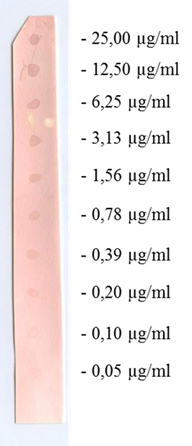
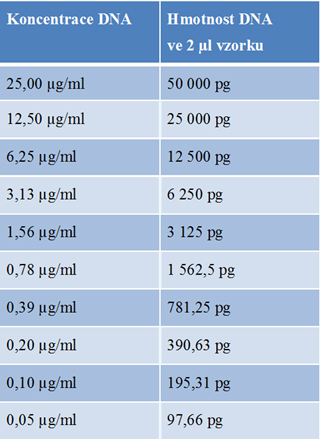
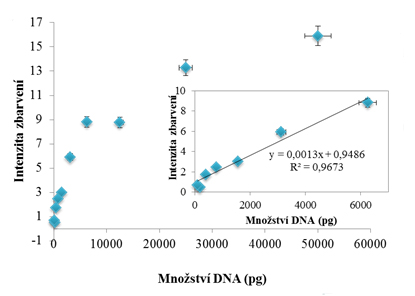

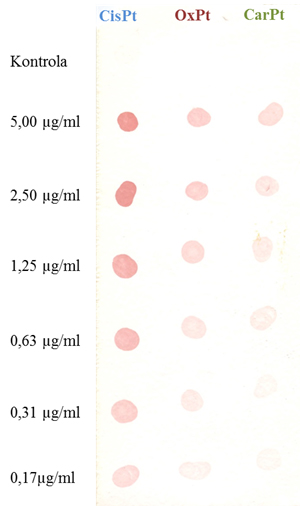
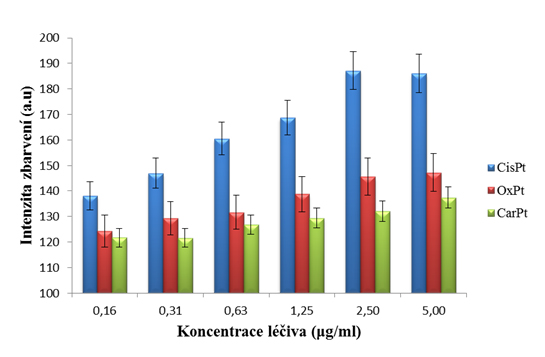
1. Scitable by nature education; Northern blot; [online]. [cit. 2014-01-20] Dostupné z: http://www.nature.com/scitable/definition/northern-blot-287.
2. Scitable by nature education; Southern blot; [online]. [cit. 2014-01-20] Dostupné z: http://www.nature.com/scitable/definition/southern-blot-289.
3. Dot Blot Analysis; Teacher's Guidebook; [online]. [cit. 2014-01-20] Dostupné z: http://www.gbiosciences.com/PDF/Protocol/502_Dot_Blot_Analysis_TEACHER.pdf.
4. Ceppellini R., Polli E., Celada F.: Proceedings of the Society for Experimental Biology and Medicine, 96, 572 (1957).
5. Rothfiel.Nf, Stollar B. D.: Journal of Clinical Investigation, 46, 1785 (1967).
6. Schur P. H., Sandson J.: New England Journal of Medicine, 278, 533 (1968).
7. Tojo T., Friou G. J.: Science, 161, 904 (1968).
8. Fuertes M. A., Castilla J., Alonso C., Perez J. M.: Curr. Med. Chem., 10, 257 (2003).
9. Wang D., Lippard S. J.: Nat. Rev. Drug Discov., 4, 307 (2005).
10. Krizkova S., Adam V., Eckschlager T., Kizek R.: Electrophoresis, 30, 3726 (2009).
J.Met.Nano:
volume-1, issue-1
- Liposomal transporters
- Modern imaging techniques
- General Mechanisms of Microbial resistance to metals
- MiRNA: From biogenesis to medical utilization
- Prion proteins and its interaction with heavy metals
- Monitoring of the role of metal ions and Metallothionein in the prion diseases development
- Viral drug nanocarriers
- Applications of micro-flow systems
- Biosynthesis of quantum dots
- Influence of different forms of glutathione on Lactobacillus casei ssp. rhamnosus culture
- Green synthesis of silver and gold nanoparticles with extracts from higher plants
- Apoferritin: nanocarrier for targeted drug delivery
- Nucleic acids detection by dot-blot method
 PDF
PDF